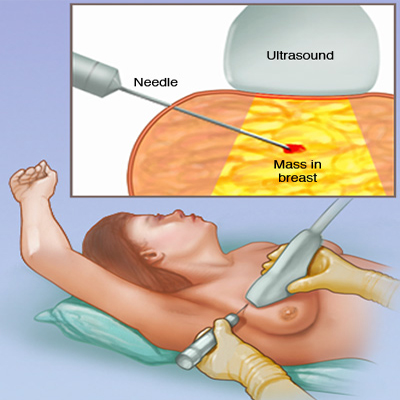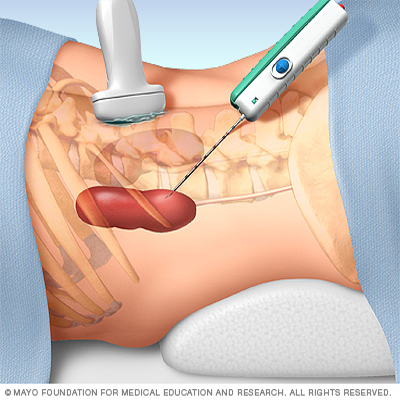During the needle biopsy
Your health care team will position you in a way that makes it easy for the doctor to access the area where the needle will be inserted. You may be asked to lie flat on a table.
In certain cases, you may undergo imaging procedures, such as a CT scan or ultrasound. These allow your doctor to see the target area and plan the best way to proceed. Imaging procedures are sometimes done before your needle biopsy and sometimes performed during the biopsy. What type of imaging you'll undergo, if any, will depend on what part of your body is being biopsied.
Your health care team will clean the area of your body where the needle will be inserted. An anesthetic may be injected into the skin around the area to numb it. In some cases, you'll receive an intravenous (IV) sedative or other medication to relax you during the procedure. Sometimes general anesthesia is used during a needle biopsy. If this is the case, you'll receive medications through a vein in your arm that will relax you and put you in a sleep-like state.
During the needle biopsy, the doctor guides a needle through your skin and into the area of interest. A sample of cells is collected and the needle is withdrawn. This process may be repeated several times until enough cells are collected.
Common types of needle biopsy techniques include:
-
Fine-needle aspiration. This type of needle biopsy uses a thin, hollow needle to draw cells from your body.
-
Core needle biopsy. This type of needle biopsy uses a wider needle than does fine-needle aspiration. The needle used during a core needle biopsy is a hollow tube that allows the doctor to extract a core of tissue for testing.
You may experience mild discomfort during your needle biopsy, such as a sensation of pressure in the area. Tell your health care team if you're feeling uncomfortable.
After the needle biopsy
Once your doctor has collected enough cells or tissue for analysis, your needle biopsy procedure is complete. Your biopsy sample is sent to a laboratory for analysis. The results may be available in a few days, though more technical tests may require more time. Ask your doctor how long you can expect to wait.
Your health care team may apply a bandage over the area where the needle was inserted. You may be asked to apply pressure to the bandage for several minutes to ensure there is minimal bleeding.
In most cases, you can leave when your needle biopsy procedure is completed. Whether you can leave right away or whether you'll need to stay for observation depends on what part of your body was biopsied. In some cases, your health care team may want to observe you for a few hours to ensure you don't have complications from your biopsy. If you received an IV sedative or general anesthetic, you'll be taken to a comfortable place to relax while the medication wears off.
Plan to take it easy for the rest of the day. Protect the area where you received the needle biopsy by keeping the bandage in place for as long as instructed. You may feel some mild pain or discomfort in the area, but this should resolve in a day or two.
.jpg)


